Emily Mariko's aspirational lifestyle content has exploded on TikTok. Her now-famous salmon rice bowl is just as easy to put together as she makes it look.
Palmer Haasch

- Emily Mariko is a lifestyle creator whose popularity recently exploded on TikTok.
- That's due in part to a viral video of Mariko making a salmon rice bowl from leftovers.
- The bowl has grown to full TikTok food trend, and we found it was just as easy to make as it looks.
Emily Mariko's content has exploded on TikTok over the past two weeks.
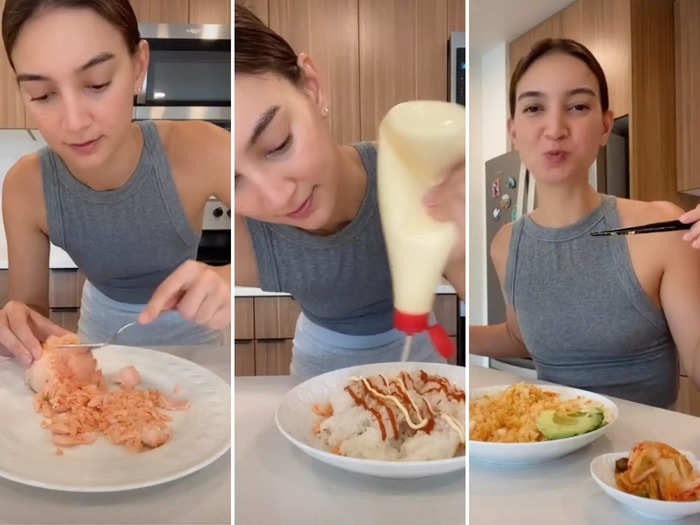
Emily Mariko — a lifestyle content creator who posts about cooking, style, and fitness — is suddenly everywhere on TikTok.
Mariko is a YouTuber with 319,000 subscribers who started posting on the platform in 2012. But her profile on TikTok skyrocketed in September as the app's algorithm seemingly pushed her videos onto many For You Pages. According to SocialBlade data, Mariko's following skyrocketed from 223,000 followers on September 16 to 2.4 million on Wednesday — an approximately ten-fold increase in just a fortnight (and now, she's on Substack, too).
Part of that incredible jump is largely due to a viral video posted on September 21 that shows Mariko making a lunch bowl combining leftover salmon, rice, soy sauce, Kewpie mayo, and Sriracha, eaten with roasted seaweed, avocado, and kimchi.
It's a simple recipe drawing on Japanese cuisine (Mariko herself is Japanese) and an ice-in-the-microwave step that helps reheat rice. Mariko's process for the dish has developed in real-time on TikTok: after she posted a version of the dish on August 25, commenters suggested she add avocado, Kewpie mayo, and the ice cube to help steam the rice, which she has since done in later iterations.
In other videos featuring the bowl, Mariko eats it with different sides, substituting in pickles like takuan, yellow pickled daikon radish, instead of kimchi.
But none of those videos went quite as viral as the September 21 version, which has amassed 3.7 million likes and 34.4 million views to date. A week after Mariko posted that video, it's got a certain corner of TikTok in a chokehold.
Mariko's salmon rice bowl went viral, eventually morphing into a full-fledged TikTok food trend.

Recreations of Mariko's dish have sprung up all over TikTok.
Mariko now posts nearly every meal she makes on TikTok, making it easy to spot when she's making salmon for dinner and hinting at leftovers the next day. The obsession with her salmon rice bowl has reached such a fever pitch that users flood her comments with excitement about the lunch bowl to come.
Even TikTok itself has commented on the trend, with the company tweeting about the recipe and commenting on one of her videos.
The path to TikTok food trend is well documented: other foods like Dalgona Coffee (which was popularized in South Korea and takes its name from a street food candy) or the TikTok-famous feta pasta (which went viral in Finland before it hit the video app) have gone down similar paths.
It's a process so rote at this point that TikTokers like @jazsocial_, who makes content about social media and trends, have made observations about Mariko's bowl careening down it as well.
That being said, Mariko's dish straddles a line between TikTok food trend and simple Japanese cuisine. Seasoning rice and eating it with kimchi, or takuan, or fish, or seaweed isn't novel – it's a staple of Asian cuisine.
I replicated Mariko's process as best as I could at home, using leftover salmon and rice, microwaving the combination with an ice cube and seasoning it with soy sauce, Sriracha, and Kewpie Japanese mayonnaise. Predictably, it was extremely good (you'd have to try for Kewpie mayonnaise and Sriracha to not taste good, or rice with roasted seaweed for that matter), and just as easy to put together as Mariko makes it appear.
I decided to try the famous lunch - and began by cooking salmon and rice the night before, in true Mariko fashion.
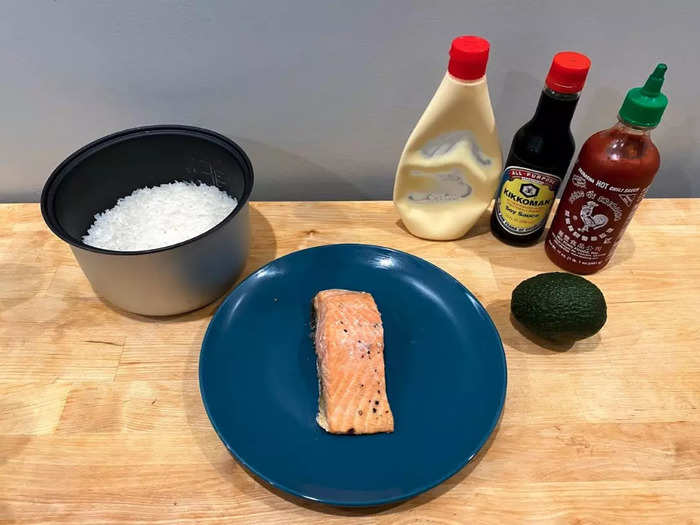
One of the biggest hallmarks of Mariko's recipe is that it features leftover salmon. I cooked a salmon fillet using Cooks' Illustrated oven-roasting method, keeping things simple and seasoning it only with salt, pepper, and olive oil.
I didn't bother removing or trimming the skin while cooking, since I knew I would be shredding the salmon the next day. I also prepared short-grain rice the night before to reheat the next day.
When I was ready to begin the process over lunch, I gathered all of my ingredients and prepared to put everything together.
I then shredded my salmon before adding leftover rice to the mixture.
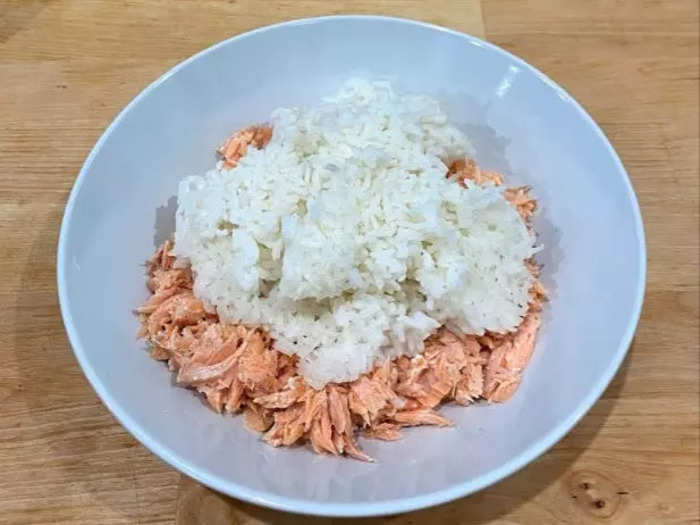
Shredding the salmon fillet was much easier than doing so with a protein like chicken. Like Mariko, I simply pressed my fork down into the fillet, gently mashing it into smaller pieces.
I then moved the salmon into a shallow bowl before placing a scoop of leftover rice on top.
I microwaved the salmon and rice with several small ice cubes and a piece of parchment paper, and the ice cubes were still intact when I removed the bowl.
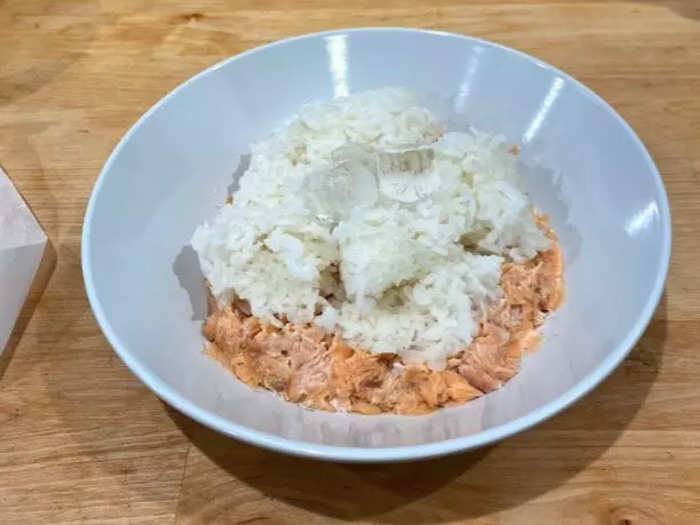
It was finally time to test out the rice reheating trick that Mariko uses in the video, which she picked up from a commenter who left the tip on an August TikTok.
Since my ice cubes are a bit smaller than the one that Mariko uses, I placed three ice cubes on top of my rice, covering the bowl with parchment paper that I scrunched down onto the mixture. I cooked it for 45 seconds, adding another 20 when it wasn't quite warm enough.
My ice cubes were still intact when I removed the bowl from the microwave. That's due to ice's crystal structure, America's Test Kitchen reported — microwaves operate by vibrating molecules in food (mostly water ones), but the molecular structure of ice means that the water molecules within don't vibrate and leave the ice intact. This particular reheating method has spread before on TikTok.
I usually reheat rice by covering it with a damp paper towel, and I found that the ice cube/parchment paper method worked comparatively well. My salmon also seemed to heat up slightly faster than the rice, but it wasn't too significant and the convenience was worth it.
I added soy sauce, Sriracha, and Kewpie mayo, although not with as much grace as Mariko.
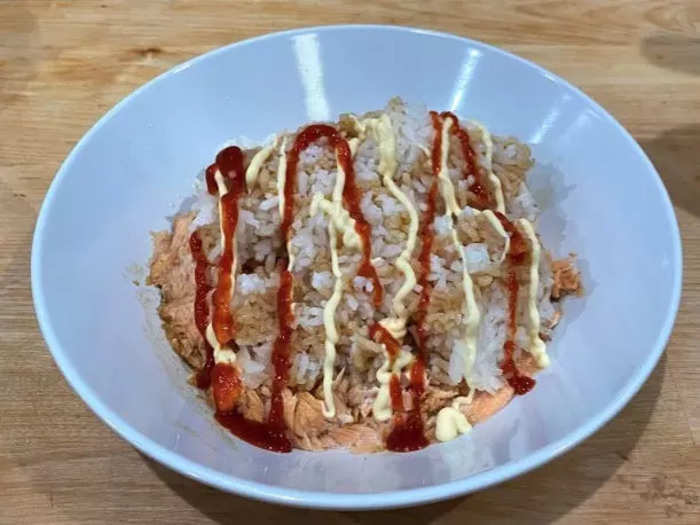
Part of the appeal of Mariko's video is the way that she drizzles her condiments — specifically the red Sriracha and white Kewpie mayonnaise — artfully over the salmon-rice mixture.
Mine did not look quite that beautiful, but it got the job done. After squeezing out mayonnaise from my close-to-drained bottle and mixing it up with the Sriracha, soy sauce, rice, and salmon, my mixture was similar to Mariko's.
Overall, Mariko's salmon rice bowl is a speedy, and delicious, weekday lunch or anytime meal.
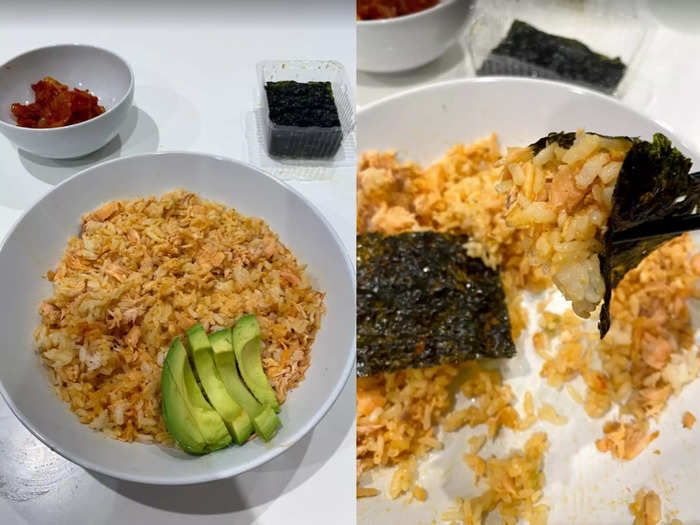
My final task in mimicking Mariko's lunch was to slice up an avocado (while beautifully bright green, mine wasn't quite ripe enough yet) and serve with a healthy serving of store-bought kimchi and roasted seaweed.
It was pretty difficult to not immediately devour it, and I was tearing open a second pack of roasted seaweed before I was even halfway through the bowl.
Mariko's salmon rice bowl was predictably just as delicious as it looks, and if I hadn't been taking photos throughout, it likely would have taken me only five minutes to prepare.
In the future, I'd likely tweak the process a bit by heating up the rice and salmon separately (if time allowed) or using fresh rice. I'd also consider eating the bowl with extra vegetables like cucumbers, serving it with a seasoned ramen egg (ajitsuke tamago, you can find a recipe from Just One Cookbook here), or adding green onions — whatever might be in my fridge.
While deviating from Mariko's process means that you're not necessarily taking part in the trend anymore — putting food on rice isn't a novel invention, nor a TikTok trend in and of itself — her content seems to be making an impact.
What Emily Mariko is selling on TikTok isn't a diet, as Mashable's Tim Marcin wrote. It's the aspirational idea that you can make food that's filling, healthy, and delicious — something that's not always common among lifestyle influencers, The Cut's Emilia Petrarca reported.
Making Mariko's salmon rice bowl over lunch forced a pause in my workday (even though I was snapping photos throughout) and helped me enjoy food that actually filled me up and tasted good. As far as TikTok food trends go, it's not a bad achievement.
READ MORE ARTICLES ON
Popular Right Now
Popular Keywords
Advertisement